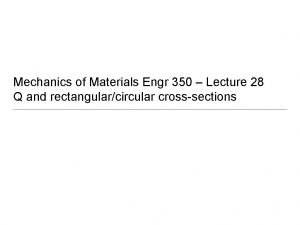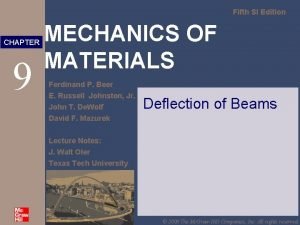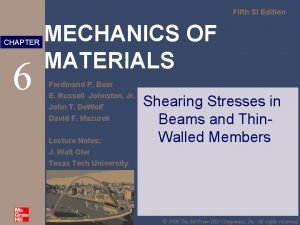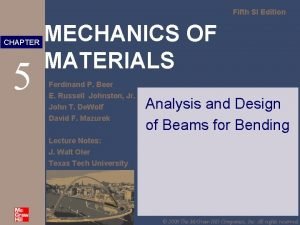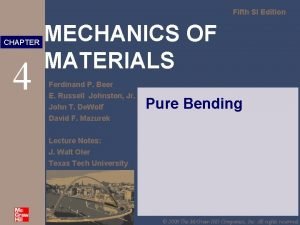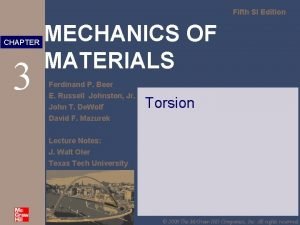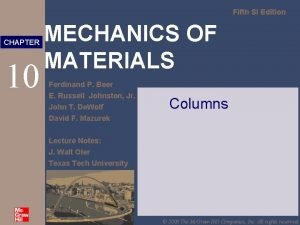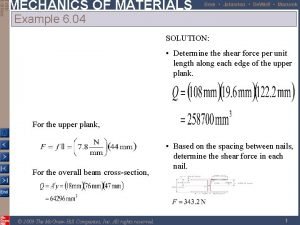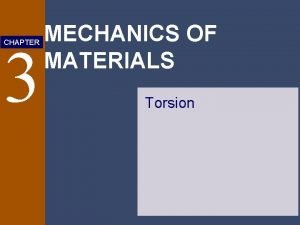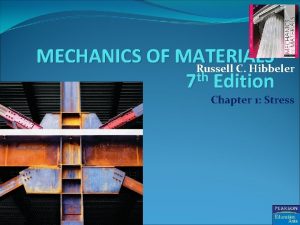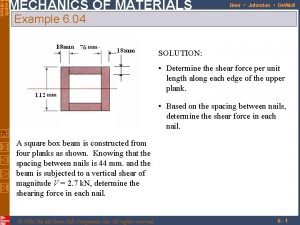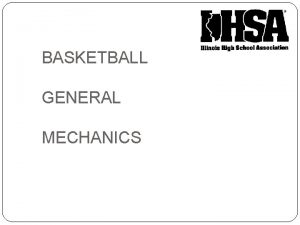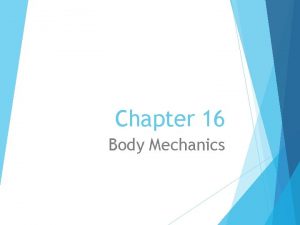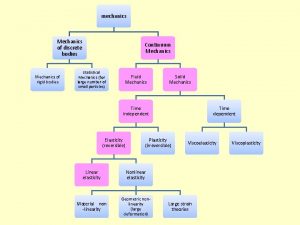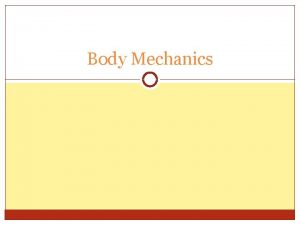MECHANICS OF MATERIALS Lecture 03 PROPERTIES OF MATERIALS













- Slides: 13

MECHANICS OF MATERIALS Lecture 03

PROPERTIES OF MATERIALS Different materials possess different properties in varying degree and therefore behave in different ways under given conditions. These properties includes Mechanical properties, Electrical properties, Thermal properties, Chemical properties, Magnetic properties and Physical properties. A design engineer is interested in the behavior of materials under load which is mechanical in nature, for the design of machines & structures. Any material subjected to a load either deforms, yield, or break, depending upon the magnitude of the load. We are basically interested in knowing as to how a particular material will behave under applied load i. e. in knowing the mechanical properties. 2

MECHANICAL PROPERTIES OF MATERIALS Before going into the question of strengths, it will be advisable to explain more or less briefly the characteristic properties of some of the principal materials used in the construction of machinery and engineering structures generally. An elementary knowledge of the properties of the various materials enables the designer to decide which particular material is the best to use for any particular purpose. An elementary knowledge of the principal processes by which iron and steel are produced is also essential to every engineer, as in specifications of engineering designs and structures it is frequently stated by which particular process the material to be employed is to be made. Certain terms relating to the properties of materials are constantly being used by engineers, and the exact meaning of these terms must 3 therefore be explained at this stage.

1. 2. Tenacity / Strength: This term is applied to denote the resistance to fracture which a body offers when subjected to a pulling or stretching force. It is the resistance offered by a material when subjected to external loading. So, stronger the material the greater the load it can withstand. Depending upon the type of load applied the strength can be tensile, compressive, shear or torsion. The maximum stress that any material will withstand before destruction is called its ultimate strength. Hardness: A body is said to possess the property of hardness, or to be hard, when it offers considerable resistance to being indented by impact or pressure with another body, or to being worn by friction with another body. It is the ability of a material to resist scratching, abrasion, indentation, or penetration. Thus machine cutting tools are made hard to prevent them from being blunted by contact with the materials they are intended to cut. 4

3. 4. Softness: This is, of course, the converse of hardness. Brittleness: When a body breaks readily on being subjected to shocks, it is said to be brittle. The brittleness of a material is the property of breaking without much permanent distortion. Therefore, a non-ductile material is said to be a brittle material. Usually the tensile strength of brittle materials is only a fraction of their compressive strength. A brittle material should not be considered as lacking in strength. It only shows the lack of plasticity. On stress-strain diagram, these materials don’t have yield point and value of E is small. There are many materials, which break or fail before much deformation take place. Such materials are brittle e. g. , glass, cast iron. Glass, is a brittle material, as it is easily broken by being struck, or by being dropped on the floor. 5

4. Ductility: This is the property possessed by certain bodies of being so constructed that they may be drawn out in the direction of their length, the elongation being permanent. Ductility of a material enables it to draw out into thin wire on application of the load. Mild steel is a ductile material. The wires of gold, silver, copper, aluminium, etc. are drawn by extrusion or by pulling through a hole in a die due to the ductile property. The ductility decreases with increase of temperature. Materials used in the manufacture of wire must possess the property of ductility in a high degree. The most ductile metals are those which possess the properties both of tenacity and softness. 6

The process of wire-making consists essentially of drawing round rods through holes in a steel faced plate, the diameter of the first hole being slightly less than the diameter of the rod, and repeating this operation with smaller and smaller holes, until eventually the rod is drawn out into wire of the particular diameter required. The material tends to become hard and brittle as a result of being drawn out in this manner. 7

5. 6. Malleability: A body is said to be malleable when it can be beaten out and extended in all directions. Malleability of a material is its ability to be flattened into thin sheets without cracking by hot or cold working. Aluminium, copper, tin, lead, steel, etc. are malleable metals. Lead can be readily rolled and hammered into thin sheets but can not be drawn into wire. Ductility is a tensile property, whereas malleability is a compressive property. Malleability increases with increase of temperature. Welding Power: Separate pieces of certain metals, when heated to a high temperature, may be joined together by hammering so as to form one piece. Such metals are said to be weld able. 8

7. 8. Elasticity: Elasticity of a material is its power of coming back to its original position after deformation when the stress or load is removed. Elasticity is a tensile property of its material. The greatest stress that a material can endure without taking up some permanent set is called elastic limit. Stiffness (Rigidity): The resistance of a material to deflection is called stiffness or rigidity. Steel is stiffer or more rigid than aluminum. Stiffness is measured by Young’s modulus E. The higher the value of the Young’s modulus, the stiffer the material. 9

9. Plasticity: The plasticity of a material is its ability to undergo some degree of permanent deformation without failure. Plastic deformation will take place only after the elastic range has been exceeded. Plasticity is an important property and widely used in several mechanical processes like forming, shaping, extruding and many other hot and cold working processes. In general, plasticity increases with increasing temperature and is a favorable property of material for secondary forming processes. Due to this properties various metal can be transformed into different products of required shape and size. This conversion into desired shape and size is effected either by the application of pressure, heat or both. 10

Toughness: The toughness of a material is its ability to withstand both plastic and elastic deformations. It is a highly desirable quality for structural and machine parts to withstand shock and vibration. Manganese steel, wrought iron, mild steels are tough materials. For e. g. , If a load is suddenly applied to a piece of mild steel and then to a piece of glass the mild steel will absorb much more energy before failure occurs. Thus, mild steel is said to be much tougher than a glass. Toughness is a measure of the amount of energy a material can absorb before actual fracture or failure takes place. “The work or energy a material absorbs is called modulus of toughness”. 10. 11

Hardenability: Hardenability is the degree of hardness that can be imparted to metal by process of hardening. A metal capable of being hardened throughout its structure is said to have high Hardenability. The material is heated above a certain temperature and then suddenly quenched in a cold oil or water bath. Hardness of a metal does not directly relate to the hardenability of the metal. Hardenability is indicative of the degree of hardness that the metal can acquire through the hardening process. i. e. , heating or quenching. 11. 12

Impact Strength: It can be defined as the resistance of the material to fracture under impact loading, i. e. , under quickly applied dynamic loads. Two standard tests are normally used to determine this property. 1. The IZOD impact test. 2. The CHARPY test. 12. Resilience: Resilience is the capacity of material to absorb energy elastically. On removal of the load, the energy stored is released as in a spring. The maximum energy which can be stored in a body up to elastic limit is called the proof resilience. The quantity gives capacity of the material to bear shocks and vibrations. 13
 01:640:244 lecture notes - lecture 15: plat, idah, farad
01:640:244 lecture notes - lecture 15: plat, idah, farad What is q in mechanics of materials
What is q in mechanics of materials Ferdinand beer
Ferdinand beer Mechanics of materials chapter 9
Mechanics of materials chapter 9 Mechanics of materials
Mechanics of materials Mechanics of materials 6th edition beer solution chapter 6
Mechanics of materials 6th edition beer solution chapter 6 Mechanics of materials chapter 5
Mechanics of materials chapter 5 Mechanic of materials
Mechanic of materials Mechanics of materials chapter 3
Mechanics of materials chapter 3 Mechanics of materials chapter 10 solutions pdf
Mechanics of materials chapter 10 solutions pdf Vertical beer
Vertical beer Torsional load
Torsional load Russell c hibbeler
Russell c hibbeler Beer johnston
Beer johnston

